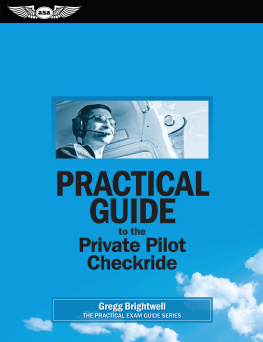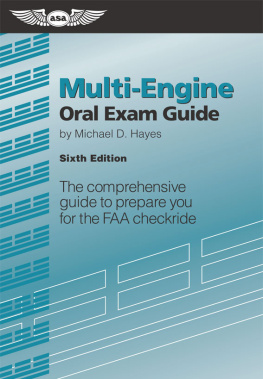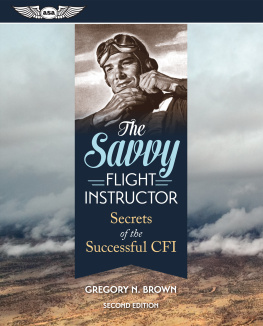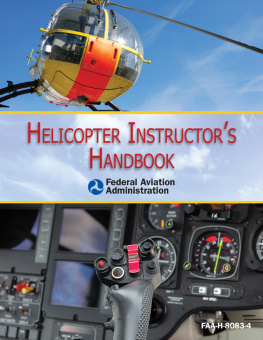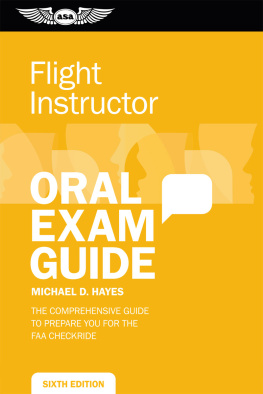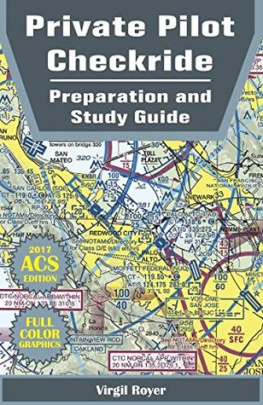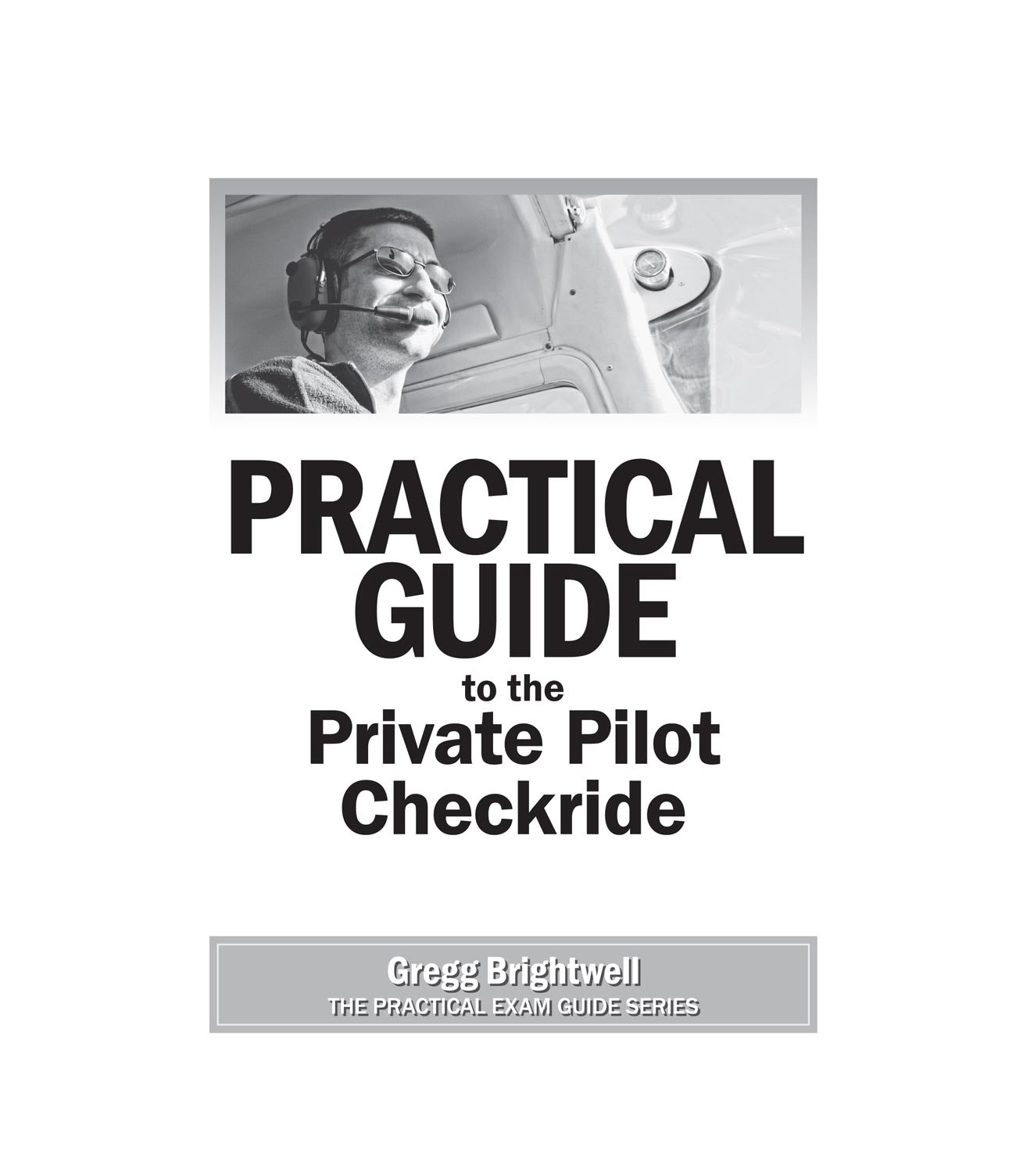THE PRACTICAL EXAM GUIDE SERIES
Practical Guide to the Private Pilot Checkride
Study guide for the ground portion of the FAA Practical Exam
Gregg Brightwell
Aviation Supplies & Academics, Inc.
7005 132nd Place SE | Newcastle, WA 98059
asa@asa2fly.com | www.asa2fly.com
2014 Aviation Supplies & Academics, Inc.
All rights reserved.
Cover photo: Shutterstock, Stacey Newman
ASA-PRACT-PVT-EB
ISBN 978-1-61954-196-2
CIP 2014031748
Acknowledgments
Throughout this book, I reference many sources and most are textual references from the FAA. Yet perhaps the most important reference source for this book is the knowledge and experience I acquired from Nanette Gaylord, CFI in the Tulsa, Oklahoma area. Her expertise has greatly benefited my CFI studies. With her help, I was very well prepared for my CFI practical exam with the FSDO in Oklahoma City, and scored high praise from the administering inspector.
About the Author
Gregg Brightwell holds a B.S. in Aviation Science, CFI(I)/MEI, AGI, ATP, and A&P certificates, and has worked for Cessna Aircraft Company as an Experimental Flight Mechanic, Production Flight Test Pilot, and Avionics Technician; currently he is a Flight Test Engineer at Bombardier Learjet. He is passionate about aviation and loves the freedom flying offers, as well as sharing this with his students.
Foreword
by Nan Gaylord
I first met Gregg when he was a student in my CFI Practical and Exam Prep Course in February 2009. I immediately recognized his spirit of excellence and demand for the pursuit of perfection. I love those traits in a personand especially in my flight instructors and pilots! His lesson plans were the best I had ever seen in my 41 years as a CFI and 25 years as a DPE (having administered more than 1,000 CFI Initial Practical Exams for the OKC FSDO). I have since used them as examples for the other students. When he told me he was going to put them in a book made available to CFI wannabes and people preparing for the mother of all checkridesthe CFI initial examI was thrilled.
It has been over a year now since the release of Greggs first bookthe Practical Guide to the CFI Checkride. I have recommended the book to all of my students taking my CFI class, for their use in helping to prepare for their practical exam. It has been a huge success with them and their results on the exams.
So I am very excited that Gregg is now offering the same type of guidance to prepare for the Private Pilot Practical Exam! Whether you are getting your private pilot certificate for the luxury of fun flying, or perhaps transportation, or beginning the first step in a new career, it is vitally important that you learn things correctly the first timein aviation we call this the Law of Primacy. I believe this book will give you the guidance to do that.
There is no mystery to passing the Private Pilot Practical Exam on the first attempt if you follow Greggs carefully laid out directions; the entire ground portion of the exam is herethe outcome will be determined by your preparation. I strongly endorse this book and think it will greatly assist you in preparing for the ground portion of the Private Pilot Practical Exam.
Good Luck and Tailwinds,
Nan
Nan is an ATP/SEL&MEL, Gold Seal And Master CFI/CFII/MEI, Master Ground Instructor/GIA&I. With over 10,000 hours, she has administered over 7,000 practical exams including over 1,000 CFI initial practical exams.
Introduction
The intent of this book is to consider the vast amount of information that aspiring pilots must learn and find ways to help simplify this task by organizing and managing it. There are dozens of FAA Advisory Circulars (ACs), official FAA manuals, and other instructional books out there that go into great detail teaching what there is to know about all things pertaining to aviation. So Private Pilot applicants read, and read, and then read some more.
Preparing for the Private Pilot practical exam is hard. It takes a lot of dedication, very disciplined studying, and can be a significant expense. Then, after all of that, you ask yourself, What is the examiner looking for? Speaking of examiner, lets clarify that term. On practical exams for other certificates or ratings, applicants can choose either a Designated Pilot Examiner (DPE) or an FAA Aviation Safety Inspector in operations. So from here forward, the terms examiner and inspector will be used interchangeably.
Back to what the examiner is looking for: as with other certificates and ratings, the Private Pilot applicant will be tested using the appropriate FAA Practical Test Standards (PTS). These standards cover the expectations, and tolerances that must be met to earn the Private Pilot Certificate. Therefore, as you begin to prepare for your practical test, where do you start? How do you organize and prioritize all this information? How do you correlate the Practical Test Standards to what youve learned in your studies? What specifically do you need to know to demonstrate mastery of a given subject? How do the Area of Operations and Tasks translate to questions you can expect examiners to ask?
These are the questions this book is designed to answerit can serve as a plain-language study guide to help you navigate through all those thousands of pages of material. This book can help you organize that material and correlate it to the FAAs training and testing document by clarifying wherever the PTS is vague about source materials.
A note: this book does not include discussions on the Areas of Operation IVXII, which is the flight portion of the practical examthese were intentionally omitted. The examiners and inspectors I queried agreed that applicants who do well on the ground portion of the exam typically do well on the flight portion. Applicants generally spend enough time rehearsing and preparing for the flight portion, yet they underestimate the significance of the ground portion.
Areas of Operation are phases of the practical test arranged in a logical sequence within each standard. They begin with Preflight Preparation and end with Postflight Procedures. The examiner may conduct the practical test in any sequence that will result in a complete and efficient test. However, the ground portion of the test will be conducted before the flight portion.
So, lets get started: Use this book as a guide to help you prepare for the ground portion of the practical test. With all this preparation, youll be better able to pull the pertinent knowledge from the original sources. There is a lot to learn, but you can do it! Are you ready to become a licensed private pilot?
Practical Test Essentials
Prerequisites for the Private Pilot Certificate
For the sake of discussion in this book, the assumption will be that you are applying for your Private Pilot certificate, in a single-engine land airplane.
What are the prerequisites to becoming a Private Pilot? The answer is in Title 14 of the Code of Federal Regulations (14 CFR) Part 61. So, lets take a look at the current FAR/AIM (Federal Aviation Regulations/Aeronautical Information Manual), at 61.103Eligibility Requirements. To be eligible to take the Private Pilot Practical Test, an applicant must:
1.Be at least 17 years of age.
2.Be able to read, speak, write, and understand the English language. If there is a doubt, use Advisory Circular (AC) 60-28, English Language Skill Standards.
3.Have passed the appropriate private pilot knowledge test since the beginning of the 24th month before the month in which he or she takes the practical test. Or, more simply put, you have 2 years from the last day of the month in which you took the knowledge exam, to take and pass the practical test. After that date, the test will expire, and must be retaken.

